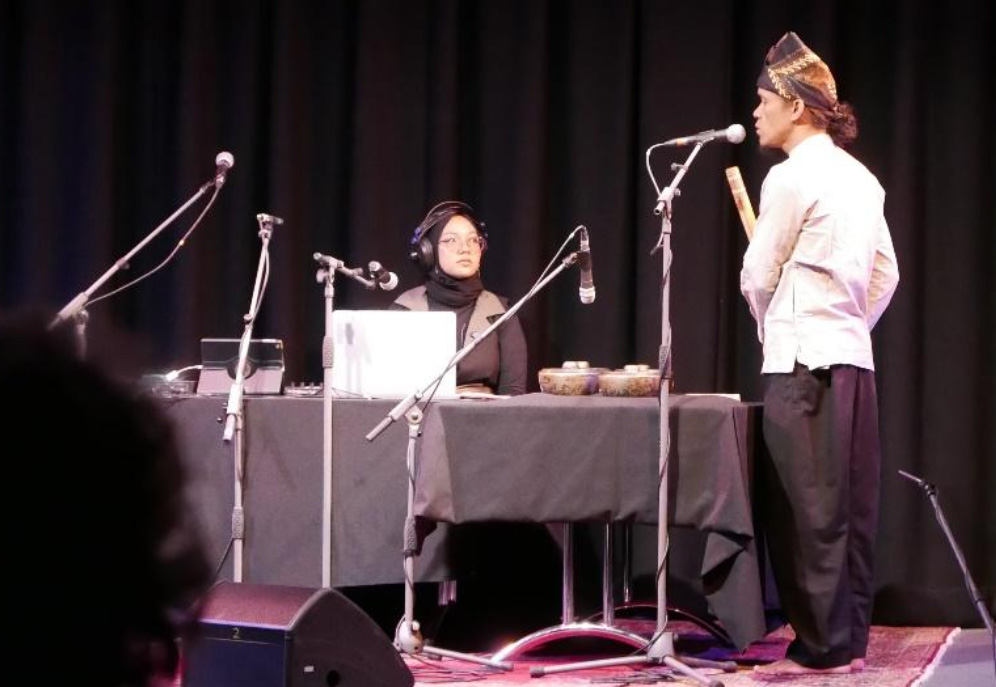Rani and Hario starting their performance at Brunei Galley Lecture Theatre. Photo by Darryl Lim.
Baco Aso Curah Raso: Reimagining the Minangkabau Soundscape
By Alan Darmawan
On the stage at the SOAS Brunei Galley Lecture Theatre on Wednesday 24 May, Rani Jambak is operating her sound pad and laptop to amplify some recorded sounds. Meanwhile Hario Efenur is playing a set of horizontal small gongs (talempong) and two kinds of flute (sarunai and saluang) in combination with Rani’s recordings. In a collaborative project with the Naskah Sumatra team through a SOAS Research Culture Fund, Rani and Hario created their soundscape by taking inspiration from a Minangkabau manuscript, Tambo Alam Minangkabau, digitised by the Endangered Archives Programme (EAP144-4-17). “Baco Aso Curah Raso” premiered at the cultural event “Resonant Pages,” in conjunction with the Leverhulme-funded Naskah Sumatra’s workshop on “Colonialism and Manuscript Libraries in Island South East Asia.”
“Baco Aso,” in the Minang language, means ‘reading the origin’, which reflects Rani’s quest for her Minangkabau identity. Born in a Minang family in Medan, Rani was raised far away from the Minangkabau homeland. Through her musical journey, Rani has been tracing her way back to her origins. Here, “Baco Aso” also means reading the Tambo Alam, which sets out the foundation of Minangkabau-ness in its encounter with Islam. “Curah Raso” stands for the “expression of feelings” from the manuscript in musical performance.

The opening pages of the manuscript of Tambo Alam from the collection of Surau Parak Laweh in Pariangan, West Sumatra. Source: https://eap.bl.uk/collection/EAP144-4
“Baco Aso Curah Raso” features the recorded sounds of nature, social activities, and text recitation to reimagine the soundscape of Minangkabau in the manuscript age. Referring to the mentions of traditional music instruments in the manuscript, Hario plays instruments like sarunai, saluang, and talempong at the live performance, combined with recorded singing of certain passages deemed to be essential in Minang culture. In a certain distinct melody, for example, Hario sings “Kaba urang kami kaba kan oi; Doso urang kami dak tau” (I tell you other people’s news, oh; Their sins I do not know). In the combination of recorded and live, traditional instruments and modern electronic devices, the piece represents the tensions between the local customs of Minangkabau and Islam.
The whole sequence of 18 minutes performance consists of three phases. The first phase illustrates the lives of people in the Minangkabau highlands, with the local customs (adat) prior to the introduction of Islam. The slow musical tempo evokes the natural scenery and village environment, with sounds of water and animals, combined with melodious and rhythmic instruments like the saluang and the small gongs talempong. Then, with the introduction of Islam in the second phase of the piece, tensions appear as represented by the beat of the membrane instrument, rebana, in a higher tempo with the recitation of dhikr. The last phase featuring the rebana and the recitation of basic principles in Minangkabau social life illustrate the acculturation and accommodation of adat and Islam. As Hario sings: customs are based on the sharia and the sharia relies on the holy book, “adat basandi sarak, sarak basandi kitabullah.”

Hario playing the saluang, while Rani provides background sound from her recordings. Photo by Darryl Lim.
This soundscape also reimagines the spatiality of Minangkabau realm, especially the community learning centres called surau. As many surau are now dormant, the piece calls attention to the Minangkabau cultural heritage, which long functioned as a centre for the transmission and production of knowledge, including of manuscripts. It is Rani’s and Hario’s opinion that surau, as a product of matrilineal Minang kinship, provides space for the men to learn, including local customs, martial art, and Islamic texts. Rani and Hario locate surau in the Minangkabau sociocultural context to represent the contestation and negotiation between adat and Islam. Born out of a collaborative effort to bridge philological scholarship and artistic creation, “Baco Aso Curah Raso” sounds the tension—and the reconciliation—at the heart of Minangkabau identity.
Alan Darmawan is a SOAS Postdoc Researcher
Acknowledgement
“Resonant Pages” was funded by the SOAS Research Culture Fund and was made possible in its organization by support from Dr. Mulaika Hijjas, Dr. Zacky Umam, Dr. Adrienne Johnson (Naskah Sumatra team), Tatiana Lima Faria (SOAS Research Office). In their research of the manuscript Tambo Alam, Rani and Hario were helped by Buya Apriya and Uda Katik in Lima Puluh Kota.

